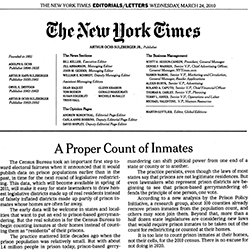Person’s home does not change with incarceration
1st Circuit US Court of Appeals confirms that incarceration does not change a person’s residence, more substantive contacts with a new location are necessary to change domicile.
by Aleks Kajstura, March 26, 2010
On Wednesday (March 24, 2010), the US Court of Appeals for the First Circuit dismissed a lawsuit filed by a man incarcerated in New York because he wasn’t a resident of the state.
One of the rules for federal lawsuits is that they have to be between people of different states; a person is unlikely to be considered a resident of a state if that person’s only connection to the state is being incarcerated there. Hall was trying to sue a New Hampshire resident, so his suit could not go forward if he was also a New Hampshire resident.
Most states have specific residence laws for electoral purposes; incarcerated people retain their home addresses as their official residence even when they are incarcerated across the state, as our new 50 state guide, finds.
These statutes reflect the general American principles of determining where someone resides. In the recent decision, in order to have his case go forward in the court, the incarcerated person bringing the suit had to prove that he was a citizen of New York, where he was incarcerated at Sing Sing prison, although he lived in New Hampshire before his incarceration.
Under generally accepted principles, citizenship is
determined by domicile, which can be established by
demonstrating that the individual is physically present in the
state and has an intent to remain indefinitely.
In cases involving prisoners, the courts presume that
the prisoner remains a citizen of the state where he was
domiciled before his incarceration, even if he is subsequently
incarcerated in a different state.
Hall v. Curran, No. 09-1354, (March 24, 2010, 1st Cir.)
In this case, the prisoner claimed that he had agreed to a civil commitment placement in Sing Sing prison, in New York State. The court, however, held that numerous contacts with the state of incarceration are not enough. Rather, “substantive” contacts are necessary to overcome the presumption that an incarcerated person remains a citizen of the state he lived in before incarceration. The court concluded that being incarcerated in New York was not enough to make Hall a resident of New York, and dismissed the case.
 The New York Times cites our newest report,
The New York Times cites our newest report, 



